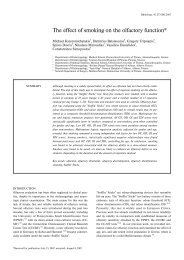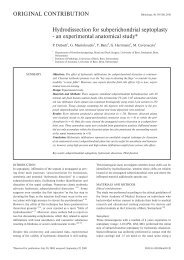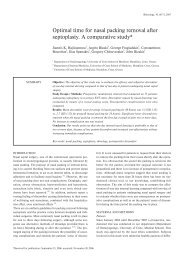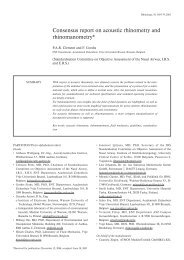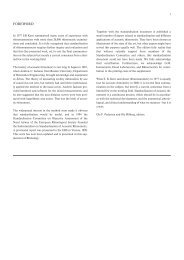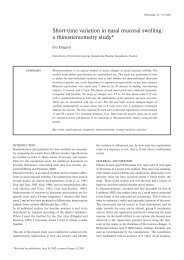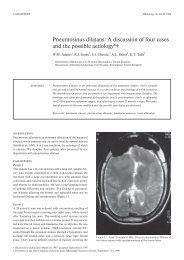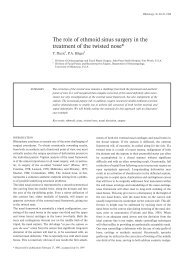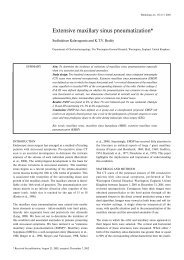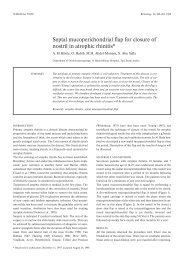IL-4 And TNF - Rhinology Internation Journal
IL-4 And TNF - Rhinology Internation Journal
IL-4 And TNF - Rhinology Internation Journal
Create successful ePaper yourself
Turn your PDF publications into a flip-book with our unique Google optimized e-Paper software.
236 Yoshifuku et al.<br />
consequence but also a cause of systemic events in non-atopic<br />
asthma. However, the mechanism by which eosinophils are<br />
selectively accumulated in nasal polyps remains unclear.<br />
It has been widely acknowledged that chemokines, such as<br />
eotaxin and regulated upon activation normal T expressed and<br />
presumably secreted (RANTES), and adhesion molecules,<br />
such as vascular cell adhesion molecule-1 (VCAM-1), are<br />
important in selectively recruiting eosinophils into the respiratory<br />
mucosa (7-9) . These factors are produced from epithelial<br />
cells, fibroblasts, and inflammatory cells and this production is<br />
up-regulated by stimulation from several inflammatory factors.<br />
In our previous study, VCAM-1 production from fibroblasts isolated<br />
from nasal polyps was enhanced by the stimulation with<br />
<strong>TNF</strong>-α (10) . Nasal fibroblasts also produce eotaxin and RANTES<br />
in response to <strong>TNF</strong>-α, <strong>IL</strong>-4, <strong>IL</strong>-13, and endotoxin (11-15) .These<br />
findings suggest that fibroblasts play an important role in the<br />
recruitment of eosinophils in nasal polyps.<br />
Furthermore, it can be speculated that the production of<br />
eosinophil-specific chemokines and adhesion molecules from<br />
nasal fibroblasts is higher in eosinophil-rich nasal polyp (Enp)<br />
than non-eosinophilic nasal polyp (NEnp), and which might be<br />
associated with the selective recruitment of eosinophils in Enp.<br />
However, the released levels of eosinophil-specific chemokines<br />
and adhesion molecules from nasal fibroblasts and the differences<br />
between Enp and NEnp have not been investigated.<br />
In the present study, nasal fibroblasts were isolated from Enp<br />
and NEnp and the released levels of eotaxin, RANTES, and<br />
VCAM-1 from those fibroblasts were determined. By comparing<br />
the released levels of these chemokines and adhesion molecules,<br />
their role in the pathogenesis of nasal polyposis is discussed.<br />
MATERIALS AND METHODS<br />
Classification of Enp and NEnp<br />
Tissue from nasal polyps obtained by surgery from twelve<br />
patients with CRS was fixed in formalin and stained with<br />
hematoxylin and eosin, and the number of eosinophils was<br />
counted at x 200 magnification under light-microscopy. Five<br />
fields were examined for each section and the average was<br />
considered the number of eosinophils infiltrating the sample<br />
(16,17) . Among twelve nasal polyps, five samples having more<br />
than 100 eosinophils and four samples having 10 or fewer<br />
eosinophils were extracted and tentatively classified as Enp<br />
and NEnp, respectively. Three samples having eosinophils<br />
between 10 and 100 were excluded from the examination. The<br />
study was approved by the Institutional Review Board of<br />
Kagoshima University Hospital.<br />
Clinical background of patients<br />
The background of the nine patients involved in this study is<br />
shown in Table 1. In the NEnp group, all patients were male,<br />
while in the Enp group, three were male and two were female.<br />
Table1. Clinical background of patients enrolled in the study.<br />
Nenp<br />
Enp<br />
No. of patients 4 5<br />
Male 4 3<br />
( Female 0 2 )<br />
Age (y.o) 15-72 48-61<br />
(mean 40.1 52.2)<br />
Nasal allergy 0% (0/4) 0% (0/5)<br />
Asthma 0% (0/4) 60% (3/5)<br />
Eosinophils (No/foeld) 0-10 116-556<br />
(Mean 3.0 349.2)<br />
The NEnp and Enp groups did not differ significantly in mean<br />
age. Nasal allergy was not found in any subject. Asthma was a<br />
concomitant disease in three of five patients with Enp. Any<br />
medicines such as leukotriene antagonist, anti-histamine, and<br />
antibiotics had not been administered to the patients at least 2<br />
weeks prior to surgery. None of the subjects had taken oral,<br />
nasal, or inhaled steroids for more than a year before the<br />
surgery.<br />
Reagents<br />
Human recombinant <strong>TNF</strong>-α and <strong>IL</strong>-4 were both purchased<br />
from CHEMICON <strong>Internation</strong>al Inc. (Temecula, CA, USA).<br />
Preparation of nasal fibroblasts<br />
Nasal fibroblasts were isolated and cultured from Enp and<br />
NEnp as described previously (18) . In brief, nasal polyps were<br />
cut into small fragments and agitated in RPMI-1640 medium<br />
containing a mixture of 10 UI/ml DNAse, 500 UI/ml collagenase<br />
type IV, and 30 UI/ml hyaluronidase (all enzymes were<br />
purchased from Sigma, St Louis, MO) on a magnetic stirrer for<br />
2 h at 37°C. The cells were then cultured at 37°C in 5% CO 2<br />
until they reached confluence in Dulbecco’s Modified Eagle’s<br />
Medium (DMEM; Invitrogen Corp., Carlsbad, CA, USA) supplemented<br />
with 10% fetal bovine serum (FBS). Fibroblasts<br />
were identified by phase-contrast microscopy and absence of<br />
contamination with epithelial cells and leukocytes was confirmed.<br />
The cells were then characterized by flow cytometry<br />
using an anti-human Thy-1 antibody (Dianova, Hamburg,<br />
Germany) in order to examine the purity; fibroblast purity was<br />
more than 99%. The cells were used throughout the study after<br />
two passages.<br />
ELISA<br />
After reaching confluence, the medium was removed and the<br />
fibroblasts were exposed to serum-free medium with human<br />
recombinant <strong>TNF</strong>-α and <strong>IL</strong>-4. The negative control consisted<br />
of cells cultured without stimulation. The cultured supernatants<br />
were collected and the concentrations of eotaxin,<br />
RANTES, and VCAM-1 in the culture supernatants were measured<br />
with sandwich ELISA kits (R&D Systems, Minneapolis,<br />
MN, USA) according to the manufacturer’s instructions.



